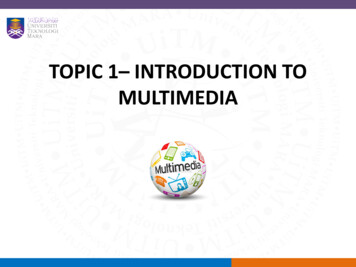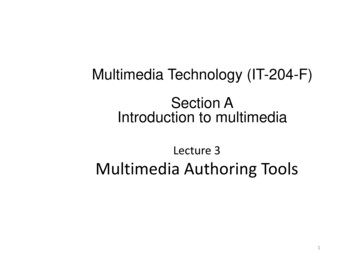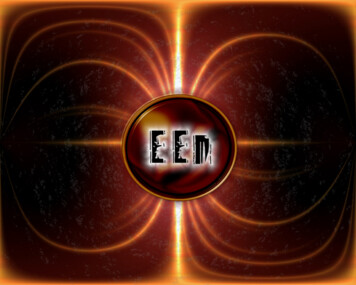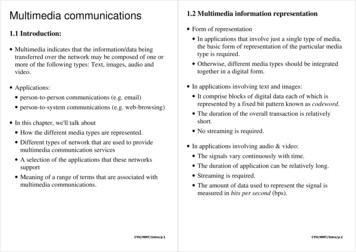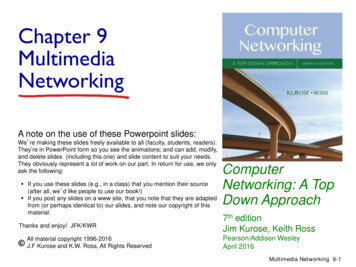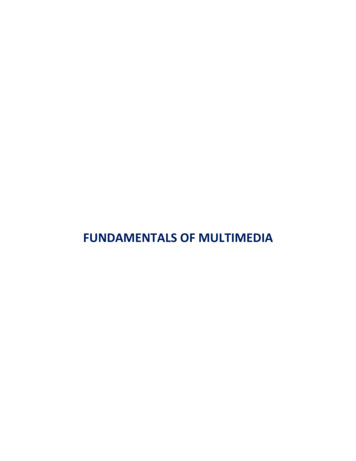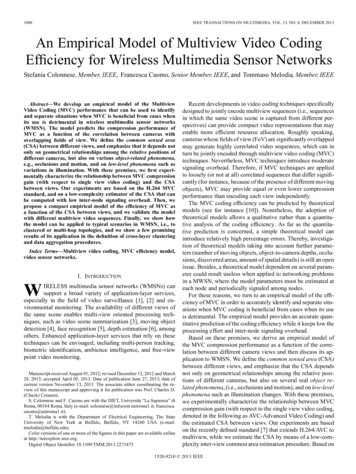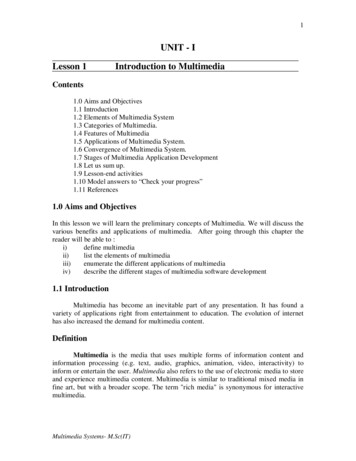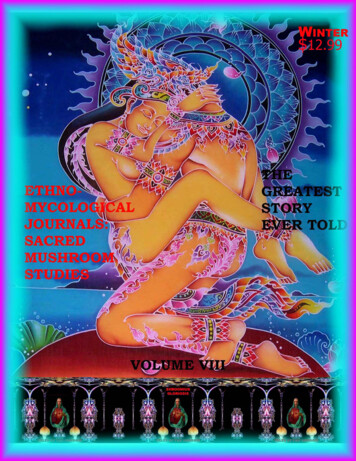
Transcription
ETHNOMYCOLOGICAL JOURNALS:SACRED MUSHROOM STUDIES VOLUME VIIIEDITED BYJOHN W. ALLENAn Albino Penis Envy Strain of Psilocybe cubensis.Copy Number of 25 Deluxe Copies.A Limited edition of 25 copies.Copies 1-25 are deluxe editions with 51 extra full color photographs.ISBN 978-1-61623-898-8Publisher: Exotic ForaysSeattle, WashingtonWinter 2009
ETHNOMYCOLOGICAL JOURNALS: SACRED MUSHROOM STUDIES VOLUME VIIIEthnomycologicalJournals: SacredMushroom StudiesVolume VIII.Winter 2009-2010.An Independent researchjournal devoted to presentingto the public, currentinformation derived fromindependent studies onpsilocybian mushrooms.Editor: John W. AllenAssociate Editor: Dr.Prakitsin Sihanonth,Department of Microbiology,Faculty of Science,Chulalongkorn University,Bangkok, Thailand.Advisor: Dr. StanleyKrippner, Saybrook Institute,San Francisco.TABLE OF CONTENTSSex, Mushrooms, and Rock and Roll .1John W. Allen.The Occurrence, Use and Detection of Psilocine, Psilocybine andBaeocystine in Psilocybe villarrealiae from Xalapa, Veracruz,Mexico . 67John W. Allen, Jochen Gartz, Prakitsin Sihanonth and Fulvio Castillo Suarez.The Occurrence, Recreational Use, Cultivation, and Chemistry ofPsilocybe ovoideocystidiata, a new Bluing Species (Agaricales) from Ohio,Pennsylvania and West Virginia . .75John W. Allen, Jochen Gartz, Prakitsin Sihanonth and Dan Molter.Cosmic Orgasmic Graphic Design . .87John W. Allen and Adisron Junlawanno.Acknowledgments . . 87Teonanácatl: A Bibliography of EntheogenicFungi: The New RevisedEdition 87Contributors: John W.John W. Allen and Jochen Gartz, Ph.D.Allen, Dr. PrakitsinSihanonth, Dr. Jochen Gartz,Dan Molter, and FulvioCastillo Suarez.Ying and Yang Graphic Shroom Art Page (Several Images) .88Design & Layout:John W. Allen. Wordand Photo Shop 9.Ethnomycological Journals: Sacred Mushroom Studies Vol. VIII. Editor: John W. Allen. Assoc.Ed., Prakitsin Sihanonth. Published by Exotic Forays. Seattle, Washington, 98145-0164. 3 FullDouble-Sided 17 X 11 Colored Pages (14-full colored pages). The first 25-signed copies (DeluxeEdition) include 51 colored images in the text of three articles. Copies 26-250, full colored cover (4Images), 65 - b & w images. ISBN 978-1-61623-898-8. cs: Workman,Spore Works Labs. PrakisinSihanonth and faculty of theDepartment of Microbiology,Chulalongkorn University forSEM photography. John W. Allenmjshroomer1@yahoo.comDr. Prakitsin SihanonthPrakitsin.S@chula.ac.thFull Moon Mushroom Dream Festival on Koh Phanghan, Thailand.
ETHNOMYCOLOGICAL JOURNALS: SACRED MUSHROOM STUDIESVOLUME VIIIThe Occurrence, Recreational Use,Cultivation, and Chemistry of Psilocybeovoideocystidiata, a new Bluing Species(Agaricales) from Ohio, Pennsylvania andWest VirginiaByAllen, John W. 1, Gartz, Jochen. 2, Sihanonth, Prakitsin3 andDan Molter4.1John W. Allen, P. O. Box 45164, Seattle, Washington, 98105, U.S.A.Email: mjshroomer1@yahoo.com2Jochen Gartz, University of Leipzig, Biotechnology-Fungal Biotransformation,Permoserstrasse 15, D-04318, Leipzig, Germany.3Prakitsin Sihanonth, Department of Microbiology, Faculty of Science, ChulalongkornUniversity, Phayathai Road, Bangkok 10330, Thailand.Email: Prakitsin.S@chula.ac.th4Dan Molter. 13 Miller Avenue, Athens, 45701, Ohio.Email: molterdan@hotmail.comAbstractCultivation and analysis of Psilocybe ovoideocystidiata, a new bluing species from Ohioand Bethany West Virginia is presented. Cultivation of this species was demonstrated onhardwood substrate. Analysis of both caps and stems revealed the presence ofpsilocybin, in most cases psilocin and always low concentrations of baeocystin.Psilocybin, psilocin and baeocystin levels varied in the bluing caps and stems of this newspecies. The highest concentrations of these alkaloids were found in both naturally grownand cultivated fruiting bodies of Psilocybe ovideocystidiata which, at the present momentis an indigenous species found in Ohio, Pennsylvania and West Virginia. The relativealkaloidal content of psilocybin, psilocin and baeocystin found in Psilocybeovoideocystidiata from Ohio was similar to that measured in Psilocybe caerulipes byLeung et al. Recent comparative chemical analysis of both species was unable to beperformed due to a denial of specimens through the University of Michigan’s herbarium.KEYWORDS: Psilocybe ovoideocystidiata, Psilocybe caerulipes, cultivation, psilocine,psilocybine, baeocystine, Ohio, West Virginia, Pennsylvania.75
ETHNOMYCOLOGICAL JOURNALS: SACRED MUSHROOM STUDIESVOLUME VIIIIndoor Cultivation of Psilocybe ovoideocystidiata.Society, editor Gary Lincoff posted acolored photograph in the “NationalAudubon Society Field Guide to NorthAmerican Mushrooms,” and PaulStamets then incorporated that exactsame photograph into his 1996 book,“Psilocybin Mushrooms of the World.”Introduction.Recent ethnomycological studies from2006 confirmed earlier reports that anew species of psychoactive agaric wasreported in 2003 from mid-eastern NorthAmerica (Guzmán, Gaines and RamírezGullén, 2007).In late may of 2003, one of the authorsof this study (JWA) was sent threephotographs of a mushroom found in awood chipped mulch-bed in a downtowngarden in Cleveland, Ohio. The threespecimens in the photograph bore aslight macroscopic similarity to that ofPsilocybe cyanescens, a potent coldweather species common to the PacificNorthwest United States. On the otherhand, this newly discovered collection ofthe Ohio mushrooms bore certainmacroscopic characteristics similar tothose attributed in the identifications ofP. caerulipes as identified by Lincoff(1981) and Stamets (1996), but the Mayto August season described by thoseabove noted authors in their guides wereentirely contrary to the seasonalappearance of P. caerulipes in the fallAt the moment there appears to be someconfusion amongst amateur mycologiststhat Psilocybe ovoideocystidiata isconspecific with Psilocybe caerulipes, amushroom described first by Peck in1892, 1887; (Peck) Sacc. (1912). Andeven more collections were lateridentified by Singer and Smith (1958),Smith (1978), Lincoff (1978), Guzmán(1983) and Stamets (1996) as P.caerulipes. Currently, there were onlytwo known photographs of P. caerulipesavailable to the public for use inidentifying the species.The firstappeared in black and white inAlexander H. Smiths, “Field guideMushrooms of the Eastern United States(Smith, 1978).” Later, the president ofthe North American Mycological76
ETHNOMYCOLOGICAL JOURNALS: SACRED MUSHROOM STUDIESVOLUME VIIIto winterDecember.monthsofOctobermisidentifying this new species as that ofP. caerulipes, basing their identificationon the senor authors macroscopicidentification of that species.toIn the fall of 2003, by using GaryLincoff’s, “Audubon Field Guide” andPaul Stamets’, “Psilocybin Mushroomsof the World,” JWA accidentallymisidentified the newly discoveredspecies of P. ovoideocystidiata as P.caerulipes.Between 2003-2009,numerous collectors of this species inOhio, Pennsylvania and West Virginiaall looked at their collections ofPsilocybe ovoideocystidiata, and beganto refer to them as “blue foot,) an epithetnormally associated with P. caerulipes.Additionally, that name appears in manyof the University of Michigan’sherbarium collections of P. caerulipes.This macroscopic misidentification byJWA; in turn, added to the alreadyconcerned confusion surrounding thecorrect identification between the twospecies, and that in turn, causedhundreds, perhaps thousands of newcollectors of these two differentmushroom species the belief that theywere both one and the same species. Andnow both species are referred to locallyin Ohio, Pennsylvania and West Virginiaas the “blue foot” ctions of P. ovoideocystidiata wereharvested in Ohio, Pennsylvania andWest Virginia and were misidentified onthe WWW at several mushroom websites as P. caerulipes. As noted above,one of the authors of this study (JWA),previouslymisidentifieda2003collection of P. ovoideocystidiata as thatof P. caerulipes. This caused numerousamateurmushroomhuntersintoFig. 1. In vitro grown specimens ofPsilocybe ovoideocystidiata.In this study, we attempted to obtain afew small collections of P. caerulipesfrom the University of Michigan’sherbarium to study them for comparativechemical analysis of their indolic contentwith that of P. ovoideocystidiata.However, permission was approved andthen denied to us by the University of77
ETHNOMYCOLOGICAL JOURNALS: SACRED MUSHROOM STUDIESVOLUME VIIIMichigan’s head spokesperson of their herbarium department saying that at this presenttime they would not be able to loan us the promised specimens for chemical analysis andfor SEM photography.Spores of the materials studied by us were obtained by one of the authors of this study, avery avid entrepreneur of edible fungi cultivation who is known locally in the nearnortheast as Mushpuppet who contributed some of the material used in this study. Thespores of his collections were studied and measurements ranged around 7.7-10.0micrometers in length, which is in good agreement with the published range for Psilocybeovoideocystidiata of (7) 8-9 (12) micrometers.Fig. 2. Spores of P. ovoideocystidiata, courtesy of Workman, Spore Works Labs.Fig. 3. Bluing in P. ovoideocystidiata, Bethany, Ohio.78
ETHNOMYCOLOGICAL JOURNALS: SACRED MUSHROOM STUDIESVOLUME VIIIFig. 4. Cheliocystidia, Spores, Basidium, and Pleurocystidium of P. ovoideocystidiata.Fig. 5. Fresh fruiting bodies of Psilocybe ovoideocystidiata, Bethany, Ohio.79
ETHNOMYCOLOGICAL JOURNALS: SACRED MUSHROOM STUDIESVOLUME VIIIFigs. 6 and 7. Fresh Specimens of Psilocybe ovoideocystidiata.and put it in the freezer in a plastic bag.The next morning, when we removed itfrom the freezer, it was frozen solid; infact, we had concerns that we may havedamaged or killed the mycelia, butfigured out that if it could survive beingfrozen in the wild, then perhaps it couldsurvive in the freezer.Indoor Cultivation of P.ovoideocystidiata by Means ofTransfer.This is really more an intuitive thanscientific experiment, and quite franklywe were surprised it worked. Usingmethods employed by a member of anInternet mushroom website bloggernamed, Mushpuppet, we were able tobring to fruit, a beautiful harvest of P.ovoideocystidiata.A collection of frozen mycelium wasgathered and bagged up, as was a largebag full of the muddy sandy-like soilfrom along the riverbank where wecollectedthemyceliaofP.ovoideocystidiata.P. ovoideocystidiata fruits in the springfrom late April to early June. Its naturalhabitat is woody debris buried in sandyloam along streams and riverbanks.For this next step we used glad-waredishes for use with the substrate of themuddy-river soil.To insure gooddrainage, similar to that of the wild, wemelted twenty holes in the bottom ofeach of the glad-ware dishes by hitting anail with a candle and then striking itthrough the bottom. We then put aboutan inch of river sand/mud in the bottomof each dish, followed by about an inchof frozen colonized woodchips/branches,twigs, etc. Then we cased the top ofeach glad-ware container with another ½inch of sandy mud.This grow is an attempt to simulate ahard winter, followed by a spring thaw,which produces a flood, which picks upcolonized wood, and buries it in the mudaccumulating along the stream bank.It was a very mild winter in 2005. Wedid have a few freezing days in earlyDecember, but since then the mercuryhas rarely fallen below freezing.We first collected the wild mycelium80
ETHNOMYCOLOGICAL JOURNALS: SACRED MUSHROOM STUDIESVOLUME VIIIFigs. 8 and 9. Indoor cultivated specimens from transplant of P. ovoideocystidiata.substrate. Then we placed the dishesinto a larger tub humidified by wetorchid moss This probably worked betterthan with perlite because it covered moresurface area), and we were able topreserve it at room temperature near awindow; often fanning and misting thetub and glad-ware containers at leastseveral times a day. Within ten days wewere finally able to see some results ofour experiment as several pins began toappear.Fig. 10. A cake of hardwood chips thathas produced a good indoor crop offresh Psilocybe ovoideocystidiata.Workman of Spore Works Labs reportedit as a “very nice grow.” He furthernoted that P. ovoideocystidiata bore aslight macroscopic resemblance to thatof Psilocybe stuntzii, basing hisNext we gave it a thorough soaking withcold tap water to wash the loose mudinto the many empty spaces around the81
ETHNOMYCOLOGICAL JOURNALS: SACRED MUSHROOM STUDIESVOLUME VIIIobservations on Dr. Gastón Guzmán’s taxonomic description of P. ovoideocystidiata(Guzmán, 2007), including the presence of a persistent annulus in the species. Workmanalso noted that, “the partial veil is thicker than the veil reported for P. caerulipes, whichis typically thin and nearly invisible as an annular zone after it breaks,” adding that henoticed that it looked “more similar to P. stuntzii” and reminded us that, “cultivatedspecimens can vary significantly from natural specimens.”Fig. 11. A crop ready for harvest. Mature fruiting bodies of P. ovoideocystidiata.Fig. 12. Observe the intense blue oxidation of psilocine as age attacks the flesh.82
ETHNOMYCOLOGICAL JOURNALS: SACRED MUSHROOM STUDIESVOLUME VIIIChemical Analysis of Psilocybe ovoideocystidiata.Mushroom masses (dry 6930.200.05-20.1720.410.100.130.1460.420.05-4 capstem0.165-0.620.450.10-0.10-5 capstem0.155-0.580.210.050.03-6 cap0.1100.750.050.20stem0.430.03Again, we see a higher concentration in the smaller mushrooms and suggest that thelow amount of psilocin detected in this species is the result of decomposition ofpsilocin in handling and drying.Fig. 13. An SEM at 3,500 X of P. ovoideocystidiata. Photo: Prakitsin Sihanonth.Herbarium Deposits of Psilocybe ovoideocystidiataSpecimens of Psilocybe ovoideocystidiata studied by Gastón Guzmán were deposited in(XAL).1) Molter, summer 2006 from Ohio2) Molter, summer 2006 from Ohio3) Molter, summer 2006 from West Virginia.83
ETHNOMYCOLOGICAL JOURNALS: SACRED MUSHROOM STUDIESVOLUME VIIIGuzmán also reported that he has “other unstudied collections from Molter which weregathered in Ohio and West Virginia.” Additional collections from 2006 by Dan Molter[and JWA] are on deposit at (Chula) in Bangkok, Thailand and in the herbarium at theUniversity of Leipzig, Germany.Fig. 14. An SEM at 5,000 X of P. ovoideocystidiata. Photo: Prakitsin Sihanonth.Fig. 15. An SEM close-up of above image at 10,000 X of P. ovoideocystidiata.Photo: Prakitsin Sihanonth.the veil remnants remained as the stemgrew 2-3 inches above the veil after ithad broken open. In Psilocybe stuntzii,Psilocybe fimetaria, Psilocybe sierrae,as well as Psilocybe cubensis, the veilalways remains very close to the openedDiscussion:Observations of this species, in both thenaturally occurring specimens, as well asthose cultivate indoors, we found that84
ETHNOMYCOLOGICAL JOURNALS: SACRED MUSHROOM STUDIESVOLUME VIIIhis field guide that P. caerulipes is"moderatelyactive;noanalysispublished." However, in 1965, Leung etal. reported the presence of bothpsilocine and psilocybin in Psilocybecaerulipes.cap. It can be observed in the abovephotos that this is a rarity in the genusPsilocybe. And this feature was notnoticed or reported by Guzmán (2007) inhis study of this new species.Regarding the quest to performcomparative analysis of Psilocybeovoideocystidiata with that of specimensof Psilocybe caerulipes, the senor authorhad gained legitimate promise for a loanof herbarium specimens from theUniversity of Michigan’s herbarium loandepartment. On May 3rd of 2007, whileworking through the Department ofMicrobiologyatChulalongkornUniversity in Bangkok, the authors hadbeen approved and promised, a fewcollections of P. caerulipes for ourresearch, by Dr, Patricia Rogers (2007),Collection Manager, of the MICHFungus & Lichen Collections.REFERENCESGuzmán, G.1983.The GenusPsilocybe: Beihefte zur Nova Hedwigiavol. 74. Cramer. Valdez, Germany. 439pp, 40 pls.Guzmán, G., Gaines, R. V. and F.Ramírez-Guillén. 2007. New Species ofhallucinogenic Psilocybe (Fr.) Kumm.(Agaricomycetideae) From the EasternUSA. International Journal of MedicinalMushrooms vol. 9(1):75-77.Leung, A. Y., Smith, A. H., and A. G.Paul. 1965. Production of psilocybin inPsilocybe baeocystis saprophytic culture.Journal of Pharmaceutical Science vol.54:1576-1579.However, by April 4th of 2008, theadministrator of the University ofMichigan’s herbarium informed thesenor author of this study (JWA), thatthey had been advised by their legalcounsel, they would be unable to sendany of their Psilocybe specimens forloan at the present time (Rabeler, 2008).Lincoff, G. (Ed.). 1981 [1997]. TheAudubon Field Guide to North AmericanMushrooms. A Borzoi book. AlfredKnopf, Inc. New York. 926 pp.Peck, C. H. 1872. Report of theBotanist. Ann. Rep. N.Y. State MuseumNatural History vol. 24:41-108.Although we had received writtenpermission for the use of herbariummaterial by Dr. Rogers, No reason wasprovided to any of us authors as to whywe were later denied this permission bya separate party from the herbarium, sowe were not able to conduct acomparative chemical and taxonomicalanalysis between the two species.Peck, C. H. 1887.Peck, C. H. 1892.Peck, C. H. 1912. New York species ofPsilocybe. Annales Rep. New York St.Mus. Bull. #157:94-105.Rebeler, Richard. 2008. Per. Comm.to JWA. Denial of Permission to usespecimens of Psilocybe caerulipes.Additionally, mycologist and cultivator,Paul Stamets, in his field guide,"Psilocybin Mushrooms of the World”(1996), erred in noting on page 105 in85
ETHNOMYCOLOGICAL JOURNALS: SACRED MUSHROOM STUDIESVOLUME VIIIRogers, P. 2007-2008, Pers. Comms., toJWA. Several letters representingpermission to obtain specimens.This is suppose to be a journal with nooutside advertising but I am pleased toannounce that coming soon from ourshroomy Canadian neighbors, the verysame cool folk who broughtshroomtalk.com to the world, a newmushroom fanzine soon to be availableonly online for amateur mushroomenthusiasts, from mycozine.com.Smith, A. H. 1978. Poisonousmushrooms: Their habitat, geographicaldistribution, and physiological variationwithin species. In: Rumack, B. H. and E.Salzman (Eds.) Mushroom Poisoning:Diagnosis and Treatment. CRC Press.Cleveland.And to everyone: Have a ShroomyDay.Singer, R. and A. H. Smith. 1958.Mycological investigations onTeonanácatl, the MexicanHallucinogenic mushrooms part two: Ataxonomic monograph of Psilocybesection Caerulescens. Mycologia vol.50(2):262-303. March-April.Stamets, P. 1996. PsilocybinMushrooms of the World. AnIdentification Guide. Ten Speed Press.Berkeley, California. 245p.Terence McKenna and John W. Allenby Psychonaut.John W. Allen. October 31, 2009Fig. 16. Fresh properly driedspecimens of Psilocybeovoideocystidiata.Reported Dosage: 2-3 dried specimensof approximately the size represented inFig. 16.86
ETHNOMYCOLOGICAL JOURNALS: SACRED MUSHROOM STUDIESVOLUME VIIICOSMIC ORGASM by Designed by JOHN ALLENACKNOWLEDGMENTSArt contributions include hand-painted batik and t-shirts designed by John W. Allen, andpainted by Adisron Junlawanno (Mr. Samui) of Ban Chewang and Wipaporn of BanNathon, Koh Samui, Thailand. Mushroom Poster of Terence McKenna and John W. Allen(courtesy of Psychonaut, the Shroomery). Photographs: Timothy Leary and John W. Allenby Ron Piper; R. Gordon Wasson and John W. Allen by Michael Aldridge; Andrew Weiland John W. Allen by Mark D. Merlin; Microphotographs of SEM: by Prakitsin Sihanonth(Chulalongkorn University), Bangkok, Thailand and spore images and Albino Penis Envyphoto by Workman (Spore Works Labs), USA; Psilocybe ovoideocystidiata (Ohio) by DanMolter and Mushpuppet; Psilocybe villarrealiae (Jalisco, Mexico) by Fulvio Castillo Suarez;Psilocybe semilanceata by Pilze (Austria); John W. Allen, Sasha Shulgin and Jochen Gartzby Troy Donohue. All other graphic images and photographs are by John W. Allen.Blurbs, courtesy of Stanley Krippner, Tjakko Stijve, Paul Krassner and David Jay Brown.Teonanácatl: A Bibliography of Entheogenic Fungi by John W. Allen with JochenGartz, the new revised CD-ROM edition, Winter 2009. More than 2840 references,2225 annotations, 9727 cross-references, 1516 screen-sized colored images. Over1,000 Pages. ISBN 1582143994. 39.99 plus 5.99 Shipping and Handling. ExoticForays, P. O. Box 45164, Seattle, 98145-0164, Washington, U. S. A.87
Alexander H. Smiths, "Field guide Mushrooms of the Eastern United States (Smith, 1978)." Later, the president of the North American Mycological Society, editor Gary Lincoff posted a colored photograph in the "National Audubon Society Field Guide to North American Mushrooms," and Paul Stamets then incorporated that exact
